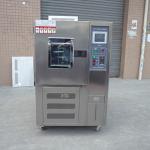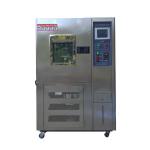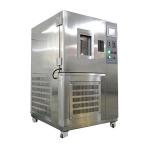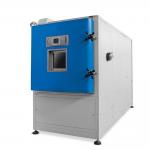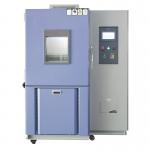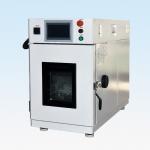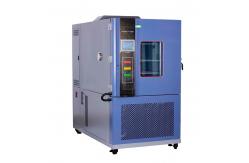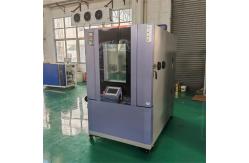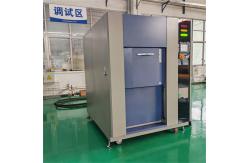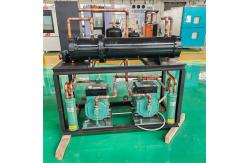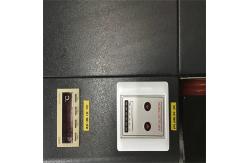In the automotive industry, the performance and reliability of a
vehicle's air conditioning (A/C) system are crucial factors that
significantly impact customer satisfaction and overall driving
comfort. The customized hot/cold test chamber room climate chamber,
specifically designed for conducting A/C system tests at the
vehicle level, emerges as a game-changing solution that offers
precise environmental simulation and comprehensive testing
capabilities. This advanced testing facility is dedicated to replicating a wide
range of hot and cold environmental conditions to evaluate the
functionality, efficiency, and durability of a vehicle's A/C
system. It serves automotive manufacturers, research and
development centers, and automotive component suppliers. The
primary objective is to ensure that the A/C system can effectively
cool or heat the vehicle interior under various extreme and
real-world weather scenarios, while also maintaining optimal
performance and energy efficiency. By subjecting vehicles to these
controlled climate conditions, potential issues such as
insufficient cooling, heating inefficiencies, refrigerant leaks,
and component failures can be identified and addressed before the
vehicles reach the market. - Large and Spacious Chamber Design
- The climate chamber is constructed with a robust steel framework
and insulated walls to create a large, enclosed space that can
accommodate a complete vehicle. The interior dimensions are
carefully engineered to provide sufficient room for vehicles of
different sizes and configurations, ensuring that the A/C system
can be tested under realistic conditions. The insulation materials
are of high quality, minimizing heat transfer between the chamber
and the external environment, and maintaining stable temperature
and humidity levels inside. The chamber is equipped with a
heavy-duty, hermetically sealed door that allows for easy vehicle
entry and exit while preventing any air leakage during testing.
- Precision Temperature and Humidity Control System
- The chamber features a highly accurate temperature and humidity
control system that can simulate a wide range of climatic
conditions. It can achieve extremely cold temperatures as low as
-40°C and hot temperatures up to +80°C, with an accuracy of ±0.5°C.
The humidity control range extends from 10% to 95% relative
humidity, with an accuracy of ±3% RH. The system utilizes advanced
refrigeration units, electric heaters, humidifiers, and
dehumidifiers to precisely regulate the climate within the chamber.
Temperature and humidity sensors are strategically placed
throughout the interior to provide real-time feedback, enabling the
control system to make rapid and precise adjustments to maintain
the desired test conditions.
- Variable Airflow and Wind Speed Simulation
- To mimic real-world driving conditions, the chamber is equipped
with a sophisticated airflow and wind speed simulation system. It
can generate adjustable wind speeds ranging from a gentle breeze to
high-velocity winds, replicating the effects of vehicle movement
and external airflows. The airflow direction can also be
controlled, allowing for testing of the A/C system's performance
under different wind angles and intensities. This feature is
essential for evaluating how the A/C system copes with air
turbulence and pressure differentials that occur during actual
driving, ensuring that the cooled or heated air is evenly
distributed throughout the vehicle interior.
- Vehicle Mounting and Monitoring Systems
- The chamber is designed with a vehicle mounting platform that
provides a stable and secure base for the vehicle during testing.
The platform is adjustable to accommodate different vehicle heights
and wheelbases, ensuring proper alignment and connection of the A/C
system components. Additionally, the chamber is equipped with a
comprehensive vehicle monitoring system that can measure and record
various parameters related to the A/C system's performance. This
includes refrigerant pressure and temperature, air outlet
temperatures at different vents, compressor speed, and power
consumption. The monitoring system is integrated with a data
acquisition and analysis software, allowing engineers to easily
access and analyze the test data in real-time or post-test.
- Sunlight Simulation and Radiation Control
- To further enhance the realism of the testing environment, the
chamber is equipped with a sunlight simulation system. It uses
high-intensity light sources that can replicate the spectral
distribution and intensity of natural sunlight. The sunlight
simulation can be adjusted in terms of intensity and angle,
allowing for testing of the A/C system's performance under
different solar loading conditions. Additionally, the chamber's
interior is designed to control and measure the amount of radiation
absorbed and reflected by the vehicle, providing valuable insights
into the impact of sunlight on the A/C system's cooling and heating
loads.
- Safety and Emergency Systems
- The climate chamber is equipped with a comprehensive set of safety
and emergency systems to ensure the protection of both the vehicle
and the testing personnel. It has emergency stop buttons located at
strategic points within the chamber and outside, allowing for
immediate shutdown of all systems in case of any abnormal
situation. The chamber is also equipped with fire suppression
systems, refrigerant leak detectors, and over-temperature and
over-pressure protection devices. The ventilation system is
designed to ensure proper air circulation and removal of any
potentially harmful gases or fumes that may be generated during
testing.
|
